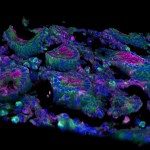Lien vers Pubmed [PMID] – 19348676
Retrovirology 2009;6:32
BACKGROUND: Foamy viruses (FVs) are the most genetically stable viruses of the retrovirus family. This is in contrast to the in vitro error rate found for recombinant FV reverse transcriptase (RT). To investigate the accuracy of FV genome copying in vivo we analyzed the occurrence of mutations in HEK 293T cell culture after a single round of reverse transcription using a replication-deficient vector system. Furthermore, the frequency of FV recombination by template switching (TS) and the cross-packaging ability of different FV strains were analyzed.
RESULTS: We initially sequenced 90,000 nucleotides and detected 39 mutations, corresponding to an in vivo error rate of approximately 4 x 10-4 per site per replication cycle. Surprisingly, all mutations were transitions from G to A, suggesting that APOBEC3 activity is the driving force for the majority of mutations detected in our experimental system. In line with this, we detected a late but significant APOBEC3G and 3F mRNA by quantitative PCR in the cells. We then analyzed 170,000 additional nucleotides from experiments in which we co-transfected the APOBEC3-interfering foamy viral bet gene and observed a significant 50% drop in G to A mutations, indicating that APOBEC activity indeed contributes substantially to the foamy viral replication error rate in vivo. However, even in the presence of Bet, 35 out of 37 substitutions were G to A, suggesting that residual APOBEC activity accounted for most of the observed mutations. If we subtract these APOBEC-like mutations from the total number of mutations, we calculate a maximal intrinsic in vivo error rate of 1.1 x 10-5 per site per replication. In addition to the point mutations, we detected one 49 bp deletion within the analyzed 260000 nucleotides.Analysis of the recombination frequency of FV vector genomes revealed a 27% probability for a template switching (TS) event within a 1 kilobase (kb) region. This corresponds to a 98% probability that FVs undergo at least one additional TS event per replication cycle. We also show that a given FV particle is able to cross-transfer a heterologous FV genome, although at reduced efficiency than the homologous vector.
CONCLUSION: Our results indicate that the copying of the FV genome is more accurate than previously thought. On the other hand recombination among FV genomes appears to be a frequent event.
